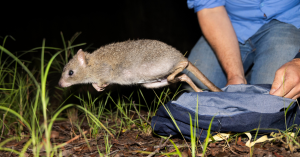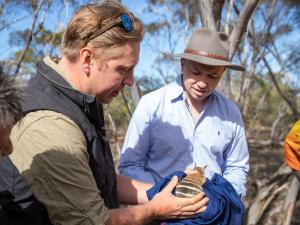With Australia facing increasing extinctions, Australian Wildlife Conservancy (AWC) has launched a 10-year plan to turn the tide on our biodiversity crisis.
The plan includes targets to impact 5% of Australia’s land mass and a 50% growth in conservation of threatened species vulnerable to feral cats and foxes, significantly reducing their extinction risk by 2035.
Backed by a $100 million fundraising drive, the plan marks a significant scale-up in AWC’s efforts to halt and reverse species loss. It was also unveiled that Matt Kean, Chair of the Climate Change Authority, and former NSW Treasurer and Environment Minister, will be joining AWC’s Board of Directors.
AWC CEO Tim Allard. said: “Australian wildlife is facing existential threats. Many species are on the brink of extinction, including the Northern Hairy-Nosed Wombat — one of the rarest mammals on the planet. We don’t have time for business as usual. The extinction crisis is here, now, and we need to act at scale.”
A Step-Change in Conservation
AWC, Australia's largest private conservation organisation, protects endangered wildlife across 6.8 million hectares, and is influencing an additional 6.1m ha through strategic pastoral partnerships. Under the new plan, its footprint will more than double to reach 5% of Australia — an area larger than Germany.
This unprecedented expansion will prioritise critical habitats for species like the Bilby, Northern Quoll, and Northern Hairy-Nosed Wombat backed by new feral predator-free areas and climate adaptation strategies.
“Australia has already lost at least 33 mammal species since colonisation — and we’re losing more every year,” said Allard. “We’re drawing a line in the sand. This plan is the boldest private response to the extinction crisis in our nation’s history.”
The appointment of Matt Kean, one of the country’s most prominent environmental advocates, reflects AWC’s growing influence in conservation policy and fundraising.
Matt Kean said: “Our wildlife is at a tipping point. This is about more than conservation — it’s about mobilising Australians to protect our extraordinary animals. I am joining Australian Wildlife Conservancy because they get results — and now is the time to raise the stakes — and speed up the response.”
AWC Chair Nick Butcher said Kean’s experience and network will be instrumental in driving greater public awareness and financial support:
“Matt understands how to turn good ideas into real-world outcomes. He’ll help us take AWC’s important conservation work to the next level.”
A Strategic Roadmap for the Next Decade
AWC’s new strategy outlines six major pillars:
1. Deliver effective conservation and help stop extinctions:
• Expand safe haven network and species reintroductions to increase protection of threatened species vulnerable to introduced predators by 50% (from 20 to 30) by 2035.
• Benefit populations of at least 80% of Australian mammal species, 95% of bird species.
2. Scale up our conservation reach: Reach 5% of Australia’s land area through land acquisition, collaboration with First Nations communities and strategic partnerships.
3. Increasing investment in nature: More than doubling financial support to allow $100 million investment per annum into the preservation of Australia’s unique landscapes and wildlife by 2035.
4. Growing support for Australia’s biodiversity: Boost public engagement through a 5% annual increase in reach and visibility.
5. Engaging and empowering employees: Maintaining a steady employee engagement rate of at least 80%.
6. Sustaining a Return on Investing in nature by staying lean and impactful: Retain best-in-class cost efficiency and innovation.
Track Record of Impact
AWC’s science-led model has already reaped conservation wins. The organisation has established 10 feral predator-free areas and reintroduced more than 20 native species — including: the first return of Bilbies to New South Wales after a century-long absence; helping avert the extinction of the endangered Northern Bettong in Queensland; and safeguarding nearly 10% of Australian’s nationally threatened mammal species at its Mt Gibson Wildlife Sanctuary in Western Australia.
“We’re proof that conservation works — when it’s targeted, scalable, and backed by science,” said Allard.
With more than 100 ecologists and land managers on staff, AWC is already a global leader in conservation — but the new plan aims to substantially impact the future of Australian wildlife and landscapes.
“This isn’t just a plan. It’s a lifeline,” said Allard. “We’re calling on Australians to get behind us, because the next ten years will decide the future of our wildlife.”
Nahrain John
Australian Wildlife Conservancy
+61 476 711 833
email us here
A Decade of Bold Action | Australian Wildlife Conservancy's Strategic Plan 2025-2035
Legal Disclaimer:
EIN Presswire provides this news content "as is" without warranty of any kind. We do not accept any responsibility or liability for the accuracy, content, images, videos, licenses, completeness, legality, or reliability of the information contained in this article. If you have any complaints or copyright issues related to this article, kindly contact the author above.




